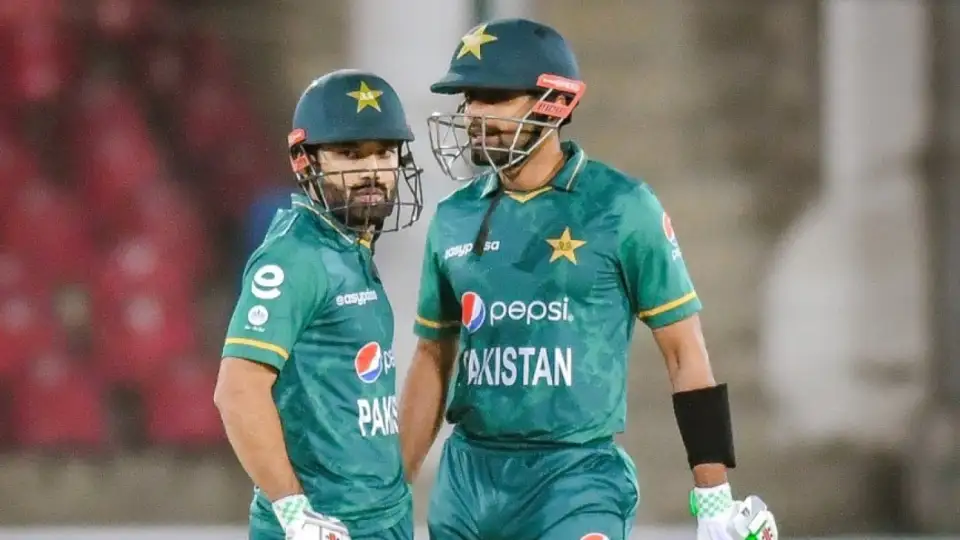Jarrod Kimber, Shayan Ahmad Khan
Pakistan in the men’s T20 World Cup and dramatic finishes dates back to the inaugural edition in 2007. They lost a thriller against India in the final then, and have had a lot of pulsating games since then. They won the title in 2009, and lost in the semifinals in 2010 when Michael Hussey completed an end-overs heist with 60* off 24. The only times they didn’t make the semifinals was in 2014 and 2016. In 2021, they were arguably the best team in the competition, but lost once again to Australia in the semifinal, in another close finish. In 2022, they ended up making the final despite losing their first two games against India and Zimbabwe.
They have made a bunch of changes to their squad from the 2022 edition though. Azam Khan, Saim Ayub, Usman Khan, Imad Wasim, Abbas Afridi, Abrar Ahmed, and Mohammad Amir make it, while Asif Ali, Haider Ali, Khushdil Shah, Mohammad Haris, Shan Masood, Mohammad Nawaz, Mohammad Wasim, and Mohammad Hasnain miss out. Fakhar Zaman played one match in 2022, before being ruled out due to a knee injury. He is also in the squad.
After the last T20 World Cup, Pakistan have played 26 T20Is (including three matches in the Asian Games, 2023) – registering nine wins and 15 losses, while two games had no results. All the T20I data for the players is from these matches.
Pakistan have several top-order options in their squad – Babar Azam, Mohammad Rizwan, Saim Ayub and Usman Khan. Zaman has also batted in the top three in this format, but he has batted at number four in all T20Is this year.
Babar, back as captain, has 668 runs in 18 innings, averaging 39 and striking at 143. In the same time period, he has 1091 runs in the PSL at an average of 44 and a strike rate of 144. Rizwan has also been a consistent run-getter, with 568 runs in 16 innings at an average of 52 and a strike rate of 136. In 24 innings in the PSL, he has scored 957 runs at an average of 44 and a strike rate of 133.
Should they open the batting? It has been a prolific opening pair for Pakistan in terms of runs, but it is not ideal to have two anchor-type batters opening the innings in modern day T20s. But if they can take more risks and maximise the first six overs, it is not a particularly bad idea.
They can also open with Ayub, who has been impactful in the PSL in the last two years, averaging 30 and striking at 161. He was excellent in the CPL last year too, with 478 runs in 13 innings at an average of 43 and a strike rate of 142. He also adds a part-time bowling option. However, he has not yet been able to translate his T20 league performances to the international level, averaging 15 at a strike rate of 128 in 19 innings.
Usman has been impressive in the last two PSL seasons too. He has smashed 597 runs in 11 innings, averaging 75 while striking at 173. He has been able to combine consistency and quick-scoring, which is not easy to find in a T20 batter. He has had most of his success in the PSL at number three. He’s relatively inexperienced at the international level though, with only five innings for Pakistan so far.
Their middle order options are Azam Khan, Iftikhar Ahmed and Shadab Khan. All three are multi-skilled, and have enjoyed good form with the bat. Azam has been striking at 165 in the PSL in the last two years (average 32), and while he didn’t score as many runs as expected in CPL 2023, his true strike rate was a significant +12.52. Azam is a wicketkeeper too, so he offers that additional utility. The one drawback he’s had is his poor form in T20Is, with only 82 runs in 10 innings. That includes an unbeaten 10-ball 30 against Ireland.
Iftikhar has decent stats for Pakistan, averaging 23 and striking at 141 in 17 innings, both of which are above par for where he’s batted. His PSL numbers are even better. He has 448 runs in 20 innings, with a true average of +16.66, and a true strike rate of +9.55. He is also a useful part-time offspinner.
Shadab has had some recent patchy form, but he’s been one of the most valuable players in the last two T20 World Cups. In 2022, he was extremely impactful on both sides of the ball. In the last two seasons of the PSL, he has scored 440 runs in 21 innings at an average of 24 and a strike rate of 142. Of those, 14 innings came at number four. He also picked up 26 wickets in 23 PSL games with his leggies, while being just under par at an economy of 8.75. True values suggest his economy rate is 0.51 runs per over more than par, while he takes 0.04 wickets more per four overs.
The allrounder does most of his work in the middle overs, but has also occasionally bowled in the powerplay and death overs. He has bowled two of his most expensive four spells in T20Is in the last three matches – none for 55 vs England and none for 54 vs Ireland.

Imad Wasim came out of retirement after this year’s PSL, where he took 12 wickets in 12 matches at an economy of 6.6 and scored 126 runs at a strike rate of 129. He brought his best game forward in the knockouts, returning with four over spells of 3 for 12, none for 23 and 5 for 23. He also scored 4 off 3, 59* off 40, and 19* off 17 respectively in these matches. He had a decent outing in CPL 2023 too, with 313 runs in 10 innings at an average of 39 and a strike rate of 130. He also took 14 wickets at an economy of just 7.16.
Since his return to the T20I side in April 2024, the left-arm spinner has picked up five wickets in six matches at an economy of 6.73. He also has 49 runs in four innings at a strike rate of 175, and has been dismissed only once. He is very good in the powerplay and middle overs, and he has also bowled a few overs at the death.
Pakistan’s pace attack played a huge part in their semifinal and final finishes in the last two editions. The two additions this time have been Mohammad Amir and Abbas Afridi.
Amir has picked up 19 wickets in 16 matches at an economy of 8.26 in the last two seasons of the PSL. He has primarily bowled in the powerplay and at the death. He is not as great a wicket-taker with the new ball as he once was, but he keeps the flow of runs in check. Abbas has the most wickets by a pacer in the last two seasons of the PSL, with 36 scalps in 20 matches at an economy of 9.07.
Shaheen Afridi was one of the best players in the world in the last two T20 World Cups, making an impact with his early wickets. Since the 2022 edition, he has picked up 33 wickets in 19 T20Is at an economy of 8.26. He has 33 wickets in 21 matches in the last two editions of the PSL, conceding 8.9 runs per over.
Afridi is the leader of the attack, and will bowl at the start and end of games. He can also be used in the middle to get wickets, but you want him to be at his best when the ball is moving around. Additionally, he has also shown improvement as a batter. In the last two PSL seasons, he made 240 runs in 14 innings, striking at 167.
Naseem Shah is considered one of the best talents in world cricket. He is an all-phase bowler who is at his best in the powerplay. His utilisation will be key, considering the amount of new ball options Pakistan have.
Haris Rauf dislocated his shoulder during the PSL, which kept him out of the game for three months. Returning against England, he took five wickets in two matches at an economy of 9.6. Since the last T20 World Cup, he has taken 23 wickets in 11 matches at an economy of 9.11. Rauf is a strike bowler who is best used at the death and in the middle overs.
The third spinner in the squad is leggie Abrar Ahmed, who was the third-highest wicket taker in PSL 2024. He picked up 16 wickets in 10 matches at an economy of 7.82. He was a plus bowler in terms of wickets as well as economy, conceding 0.61 runs per over lesser and taking 0.51 more wickets per four-over spell than expected.
A possible XI for Pakistan could be: Rizwan, Babar, Usman, Fakhar, Shadab, Iftikhar/Azam, Imad, Naseem, Shaheen, Amir, Rauf.
If they want to accommodate Ayub, one of Rizwan or Babar could shift down to number three. Shadab’s bowling form will be crucial, because they can then bench a bowler and play both Iftikhar and Azam. In that case, they will have more batting depth with Imad at number eight. On a spin-friendly surface, Abrar could come in for one of the seamers.
Pakistan have a mix of anchors, hitters, pacers, and spin-bowling allrounders. They have not been in great form in the lead up to the T20 World Cup, but write them off at your own peril.
Stats from Cricmetric, Howstat and ESPNcricinfo’s Statsguru. True stats as of 26th May, 2024 by Varun Alvakonda.




